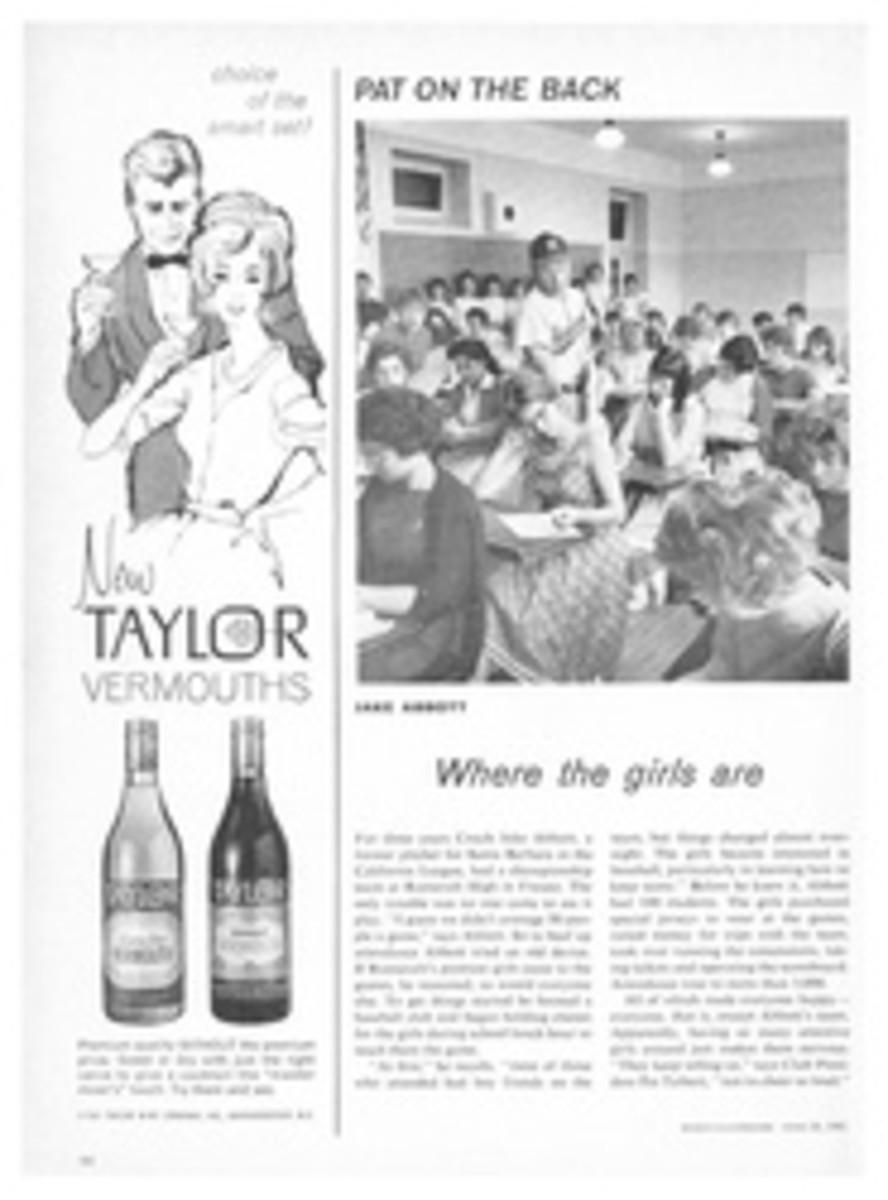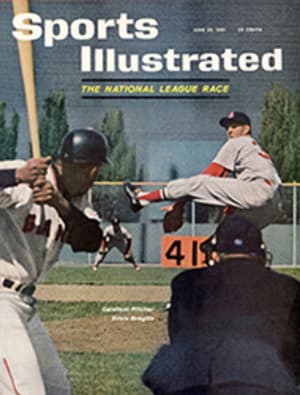
Fiancée of Danger
Last January, during one of the bitterest cold spells of the winter in Europe, an 86-year-old woman in Nancy, France bundled herself in a heavy overcoat and three wool sweaters, pulled a pair of goggles over her eyes, mounted a bicycle, waved to her neighbors and pedaled off toward Paris, 175 miles away. She rode 10 hours daily, across the frigid plains of eastern France, over mountains, through cities and villages where she attracted the whimsical attention of townsfolk. Every two hours she stopped to rest in the countryside, leaning her bike against a tree and spreading a blanket on the frozen earth and nibbling cold cuts and vegetables from the 30-pound knapsack strapped to her aged shoulders.
At dinnertime she stopped at the best restaurant in the area, where she stood inside the entrance—as erect and alert as an Air Force recruit—until she was recognized by the maitre d'h√¥tel. The ma√Ætre came over to her and said in French, "You are...that is, do we have the honor of...it is Mademoiselle Marie Marvingt, isn't it?" Then she seated herself at a choice table and consumed a light dinner, interrupted by a dozen customers seeking her autograph. There was, of course, no bill to pay. She was the guest of the house, as she is the guest of most good restaurants in France.
For six days she pedaled, until one morning she reached the city limits of Paris, coasted slowly down the Champs Élysées, around the Concorde and pulled up in front of the Ritz Hotel—the city's best—where a suite overlooking the Place Vend√¥me awaited her. That afternoon she was at an air base outside Paris—making a solo flight at the controls of a helicopter.
Unusual? Not for Marie Marvingt. She bicycles 1,000 miles every year, "just to keep in shape." She is France's greatest living adventurer. Seldom have the qualities of bravery, endurance, spirit and a love of danger been so clearly evident in a single person.
Marie Marvingt was the first licensed woman pilot in the world (1910). She was the first woman to cross the English Channel in a balloon. She won a swimming meet in the English Channel, defeating both male and female competitors (1906). She has been awarded prizes for poetry, painting and writing. She starred in a movie (The Wings that Save). She organized the first civilian ski school in France (1905). She is an accomplished boxer, fencer, trapeze artist, jujitsu expert. She competed against an army division in rifle marksmanship and won. She is a competent surgeon. She speaks five languages. She was the first woman to cross the Sahara by car (1935). She was a sponge diver off the coast of Tripoli. She trekked 40 miles alone through the French Alps. She was a war correspondent during the Riff campaign in North Africa. She hunted seals in the Arctic (1908). She holds more than 30 medals, awards and ribbons for skiing, skating, bobsledding, swimming, flying and mountain climbing. She is the most decorated woman in France, a land of decorations.
In the bewildering panorama of Mademoiselle Marvingt's adventures it is difficult to find the nature and heart of the woman herself. Shy, she is known to most Frenchmen but to few Americans, although she has twice traveled all over the U.S. on extensive lecture tours (in 1935 and 1937).
She is prouder of her friends and of the famous men and women she has known and worked with than of her adventures. "Nothing I have done has been done solely for the thrill involved or for the publicity but for what it can teach me about nature, mankind and myself. When people ask me why I have done these things—undertaken these risks and challenges I have to give them the same answer the mountain climber gave when someone asked him why he kept trying to climb Everest: 'Because it is there.' And that's why I became an adventurer, if you will—because there were things to be conquered, to be done."
The will to conquer was instilled in Marie early in life by her father, a postmaster, who taught her boxing, hunting, swimming, fishing and jujitsu. When Marie's mother died, the girl found herself, at 14 (in 1889), in charge of a household of four brothers and sisters whom she cared for while devouring books by explorers and scientists. When other girls her age were at home knitting, Marie was at the local railroad station, where she persuaded an engineer to let her ride in the cab of a steam locomotive so she could "see what made it go." Never able to decide on a single area of endeavor, Marie decided on all of them, and has been described by a friend as "a Jack-of-all-trades, and master of most."
Before the turn of the century Marie had driven a steam locomotive by herself and had won three major bicycle races. With the 20th century, with her own maturity and with the development of the airplane and the balloon, Marie Marvingt's star began to soar. Although fascinated by aeronautics, she still found time for another interest, mountain climbing, and scaled the Grepon peak in the French Alps. There is a statue of her in the Alps, celebrating her mountain-climbing feats.
In 1901 Mademoiselle Marvingt had her first ride in a balloon. Over the years her interest in and affection for balloon flight grew, and while she continued to amass awards in nearly every field of athletic endeavor, she knew in 1901 that "my greatest adventure, my biggest achievement will come in a balloon." She was right. At 11 a.m. on October 26, 1909 in Nancy, surrounded by a huge crowd, Mile. Marvingt and an aeronaut named Emile Gamier stepped into the basket of a hydrogen-filled balloon. They disappeared through the clouds to begin the first attempt by a woman to cross the English Channel by balloon.
"The balloon held 900 cubic meters of hydrogen," she recalls. "It was called The Shooting Star and was the very last word in balloons. I'll never forget the trip as long as I live."
The Marvingt-Garnier balloon was virtually unnavigable. When The Shooting Star took off from Nancy a rope connected to the ground tilted the gasbag and released pounds of precious hydrogen.
The balloon sailed north from Nancy at an altitude of 1,000 feet over the German border, past the Krupp factories at Essen, past dazzled schoolchildren and peasants. Because of the hydrogen lost at take-off, the balloon wouldn't rise higher than 1,200 feet. Near Essen the wind shifted suddenly and carried the craft northwest over Holland toward Amsterdam. "We were in the clouds most of the time," said Mademoiselle Marvingt, "but we thought after we reached Amsterdam that the most dangerous part of the trip was over. We knew we were losing altitude, but we knew that the Channel winds would sweep us over to England before nightfall."
The wind did carry the balloon off the Continent and over the Channel. But the temperature dropped to below freezing, and the basket began to rise and fall dangerously close to the waves. Before Marvingt and Gamier were five miles offshore they found themselves in the middle of a snowstorm.
Marie threw out the last of the ballast, but still the balloon wouldn't rise more than 100 feet above the waves, often dipping until the basket actually was in the water.
Night came, and the balloon continued bobbing into the choppy Channel. "My overcoat and wool stockings were no help," Marvingt said. "I was freezing. Besides that, we couldn't tell which way we were heading."
After battling the storm for five hours, the balloon suddenly lifted and rose through the clouds. Two miles distant Marie saw a light. It was the English coast. The balloon started to lose altitude and was headed toward the cliffs on the coast when an updraft caught it and lifted the pair over the top.
"It was still dark," Marie said. "We let out most of the hydrogen and put down in a pasture half a mile from the coast [near Southwold]. We barely had the energy to climb out of the basket. The next day we took a train to London, where we were treated as heroes."
The Channel crossing took 14 hours and was Marie Marvingt's most memorable exploit, but it wasn't her last. That same year she won a closed-circuit speed race for airplanes and a world bobsled championship (the first woman ever to do so). Fascinated by the humanitarian possibilities of aviation, she applied both her nursing skill and pilot's experience to designing an ambulance-plane, which during World War I carried a total of 7,000 wounded soldiers. But even air-nursing was too tame for her. Shortly after the declaration of war, she talked a general into letting her join the army and served six months in the front lines dressed as a man. About 1923 Mademoiselle Marvingt experimented with metal skis on the Sahara sands and founded a ski school for Moslems.
In addition to the dangers she has deliberately sought, Marie Marvingt has found others she wasn't looking for. In 1912 an excursion boat on which she was riding capsized, and she had to swim 12 hours before being rescued. When she was 60 she was attacked by two bandits but, utilizing her early boxing training, she managed to knock one out and send the other scurrying away with a broken nose.
Her life of adventure has left her no time for la vie conjugate. "I will always be simply mademoiselle," she confided to an interviewer last month. "I couldn't bear the ties of marriage, and I don't think any man would put up with me for long. I'm more interested in mountain climbing than in washing dishes."
At 86, the daring mademoiselle lives in an attractive apartment in Nancy, preparing her memoirs and receiving old friends. She is in superb physical condition, proud that she hasn't seen a dentist in years, has perfect hearing and can read without glasses. She sleeps-four hours nightly, declines large meals ("bad for the liver"), prefers six or seven snacks daily.
"I eat like a mountaineer," Marie said. "A healthy diet for everyone should consist of tender red meat, plenty of chocolate and sugar and fruit." She eschews spicy food, boiled beef, bread ("It's badly made these days") and alcohol of any kind.
"When I die," she said, "the city is going to build a museum to hold my trophies. When I was ill many years ago they decided my time had come and that it would be nice to inform me of their plans to build a museum in my honor after I was gone. So every few days since then somebody has come to look in and see if Marvingt is still around, and if they can start work on the museum. This has been going on for a long time. They are starting to lose interest."
PHOTO
MARVINGT SMILES BEFORE TAKING OFF IN MONOPLANE WITH HER INSTRUCTOR IN 1909
PHOTO
EAGLE-SPREAD arms balance Marvingt as she jumps on slope at Chamonix in 1903.

